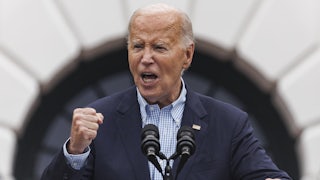President Joe Biden’s poor debate performance and the consequent Democratic outburst of panic and rage largely overshadowed the end of this year’s U.S. Supreme Court term, which concluded last week with a bombshell decision on presidential immunity. The court held that presidents have absolute immunity from prosecution for official acts taken while in power, although private actions are not subject to immunity. It was a significant victory for Trump, as it all but ensured he will not face a criminal trial ahead of the upcoming presidential contest regarding his efforts to remain in power despite losing the 2020 election.
“This is devastating to many people who might look at the Supreme Court as an institution that could be relied on to protect democracy,” said Skye Perryman, senior adviser at Demand Justice, a progressive judicial advocacy group, which recently launched a $10 million campaign to both push for court reforms and engage voters affected by recent rulings. It has also invested $2 million in an effort focusing on engaging mothers in battleground states, with an emphasis on the court’s role in determining abortion access, health care, and gun control.
The court’s composition—and the ways in which it has transformed American politics and the judiciary’s role in it—is arguably the most important consequence of the 2016 election. Although the 2022 Dobbs decision overturning the right to an abortion is perhaps the court’s best-known ruling this decade, the justices have also handed down key rulings narrowing voting rights, expanding access to firearms, limiting corruption laws, and rolling back environmental regulations. The court includes two of the four most conservative justices to sit on the Supreme Court since 1937—Samuel Alito and Clarence Thomas—according to recent data analysis by professors from Washington University in St. Louis and Penn State.
The decision on presidential immunity was just one of several rulings this summer with long-lasting repercussions for the American political system. Collectively they illustrate the extent to which the Supreme Court justices have placed themselves and the judicial branch at the center of U.S. politics and policymaking. “This particular Supreme Court has made it such that they are the final arbiters of what can and cannot be in this country,” said Devon Ombres, senior director for courts and legal policy at the Center for American Politics, a progressive think tank. He added that the court has become “effectively the primary policymakers in this country,” arguing that presidents and lawmakers will be unable to enact progressive policy agendas.
It marks the culmination of a long-term conservative legal strategy aimed at remaking the judiciary. Where the right once inveighed against judges making policy from the bench, they are now reaping the rewards of what critics deem a new conservative judicial activism. “None of this was an accident,” former Trump White House counsel Don McGahn told The New York Times. “It was a way to corral the runaway bureaucracy to get judges in place who were actually going to read the law as it was written.” He was speaking about the court’s recent administrative law rulings, but his comments were relevant to a number of decisions since the Senate cemented a 6–3 conservative supermajority four years ago.
This term particularly demonstrated the court’s willingness to reshape American governance. There were a disproportionately high number of 6–3 decisions this spring and summer, indicating a court often fragmented on the role of the federal government in American life, although not all of those fell neatly along ideological lines. Still, while the three liberal justices and the president scored a handful of victories—the court ruled in favor of allowing access to abortion medication and emergency abortion procedures, and upheld a law barring domestic abusers from owning firearms, among other decisions—the session will be remembered for rulings that diminished the power of federal agencies to set regulatory policy, lengthened the period of time to bring a legal challenge against an agency’s actions, and weakened regulatory agencies’ enforcement capabilities.
Collectively, and especially in the ruling that overturned the doctrine of Chevron deference, which required courts to defer to reasonable legislative interpretation by regulatory agencies, the decisions have limited agencies’ independence and reach while empowering courts. “In every sphere of current or future federal regulation, expect courts from now on to play a commanding role,” liberal Justice Elena Kagan wrote in her dissent against overturning Chevron. “It is a role this court has now claimed for itself, as well as other judges.”
Trump’s surprising 2016 victory set this up by giving him the rare opportunity to nominate three justices to the court, each confirmed by a Republican-controlled Senate. This was in large part a result of planning by conservative judicial networks, Perryman said, which “have sought to shape the court, using political actors to do so.” The Judicial Crisis Network, for example, helped fund a campaign at the end of the Obama presidency to keep the seat vacated by the death of Justice Antonin Scalia open until the election—denying Obama his nomination, and allowing Trump to name Neil Gorsuch as the conservative jurist’s successor. The Federalist Society, a conservative legal organization led by judicial activist Leonard Leo, has also had an outsize role in influencing modern jurists on every level of the federal bench.
Republicans argued in 2016 that a vacancy shouldn’t be filled in an election year, before reversing course four years later by confirming Amy Coney Barrett to succeed the late liberal Justice Ruth Bader Ginsburg barely a week before the election. (Those two appointments sandwiched a third controversial nominee, Brett Kavanaugh, whose confirmation Senate Republicans pushed through a month before the 2022 midterm elections.)
Conservatives have enjoyed their long-term plans’ success in the form of some of the decisions made by the court this term, especially overturning Chevron deference, which has been used by the federal government for decades to defend regulatory policies. “We’re restoring self-government, and dismantling a lot of the bureaucracy that is completely unaccountable to the voters,” said Republican Senator John Cornyn.
Adam White, a senior fellow at the American Enterprise Institute, a conservative think tank, argued that there is a consistency among the court’s conservatives in broadly wanting to constrain executive power and preventing flip-flops in policy between administrations. (Environmental advocates, however, warn that this will endanger future administrations’ ability to set climate-related policy.)
From the conservative perspective, the court’s decision this term to overturn Chevron, diminishing executive agencies’ authority to set regulatory policy, could more easily prevent one administration from pulling a complete 180-degree turn from its predecessor. Some even view the immunity decision, which appears to dramatically expand presidential authority, as guarding against a new president targeting their predecessor.
“The last part of the majority opinion in the immunity case is very, very concerned with problems of instability from one administration to the next, each new administration wanting to punish its predecessors,” said White. However, he acknowledged the dissonance in emboldening the presidency in one arena while constraining it in another, adding: “It’s also fair to point out that the immunity decision empowers presidents, while judicial review of administrative action deters presidents.”
Progressives worry that the conservative-majority court would, under a second Trump presidency, essentially green-light the policy goals outlined in Project 2025, a blueprint of conservative agenda items for a future Republican presidency spearheaded by the Heritage Foundation, including deregulation efforts and giving the president greater control over the Justice Department. Although Trump has attempted to distance himself from Project 2025, many of its architects are former Trump officials and conservative thinkers who may hold influence in a second Trump presidency, and his super PAC has highlighted it in advertising.
The court is already lining up other potential landmark cases for its fall term, with plans to hear a challenge next fall to a Tennessee law preventing transgender minors from receiving gender-affirming care. Abortion rights advocates also note that the court upholding access to mifepristone, the abortion medication, does not preclude future rulings that bar its use based on different criteria. Project 2025 aims to restrict access to mifepristone based on the Comstock Act, which prohibits the mailing of abortion medication across state borders; Ombres worried this court might uphold such an action. Thomas himself has also suggested the rulings that legalized same-sex marriage and access to contraception could be revisited.
The 2024 election may play a similarly pivotal role in reshaping the court. Cornyn argued that the Supreme Court was “one of the most important legacies of the Trump administration and the Republican majorities in the Senate that confirmed these judges.” Trump’s three appointees—Gorsuch, Kavanaugh, and Barrett—are all under 60, and so may serve on the court for decades more. But Alito and Thomas are both in their mid-seventies, and Chief Justice John Roberts is 69, raising the prospect of a potential vacancy or vacancies in the next presidential term. On the other end of the bench, liberal Justice Sonia Sotomayor is 70, leading some progressives to urge her to retire this year, while there is still a Democratic president in office to name her replacement. (Of course, even the oldest serving justice, the 76-year-old Thomas, is younger than both 81-year-old Biden and 78-year-old Trump.)
Given the court’s rightward lurch, the mere potential of making future appointments to it may prove to be a salient campaign issue, as Democrats try to hold onto both the White House and their tenuous Senate majority.
“We would have a very bad court be transformed into a very, very, very bad court if Trump won,” said Senator Peter Welch, a Democrat who sits on the Judiciary Committee. “He’d probably get more appointments, and they’d probably be at least as bad or even worse than the Trump [first term] appointments.”
As the Senate has the power to confirm a president’s nominees, the Supreme Court could be an important campaign message for vulnerable Democrats locked in tight races. “The stakes of this election and the consistent consequential cases ahead of courts across this country underscore the importance of protecting Democrats’ Senate majority with the power to confirm or reject Supreme Court justices,” said Tommy Garcia, spokesperson for the Democratic Senatorial Campaign Committee.
It may also prove a reason for skittish Democratic voters to stay the course with their party nominee, fearing that a conservative-majority Supreme Court could continue to embolden a Trump presidency—particularly given the immunity decision.
“A president in this context could order that voting machines be taken and destroyed. They could undermine every election moving forward, and we could very much become an illiberal democracy in the vein of Hungary or Russia,” said Ombres. “And this court, with a 6–3 majority, seemingly is willing to let that go.”
This article has been updated.








